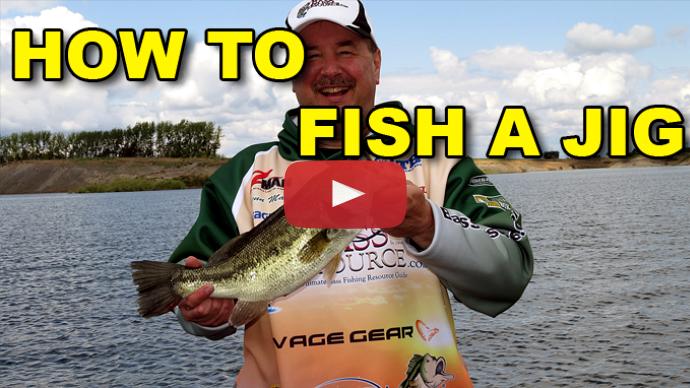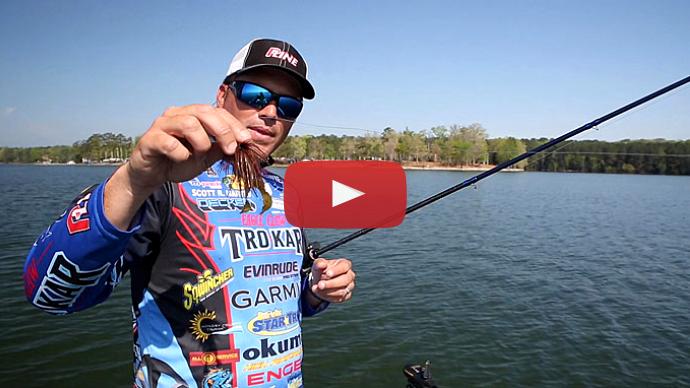Keri: Hey folks, Keri May here with BassResource.com. We're talking to Skeet Reese. I actually got this angler's name right, finally. It's been taking me a while, trust me. And we're gonna ask him his best three tips for jig fishing.
Skeet Reese: Best three tips for jig fishing. One, I've just learned and I've gotten this year is a Berkley Maxscent Meaty Chunk Jig Trailer, fish don't let go of it, so that helps you land a lot more fish. Fishing slow is probably one of the most important tips. And fishing a fluorocarbon, which I use a Trilene Fluorocarbon to be able to keep your jig in the bottom and get better sensitivity and better hook sets.
Keri: Brandon is gonna tell us his top three tips for jig fishing.
Brandon Palaniuk: Okay, for jig fishing, my first one is gonna be applying the right jig to the style of fishing you're doing. And what I mean by that is if you're fishing offshore, you don't wanna be throwing a big giant flipping jig, you wanna be throwing a football style or some type of finesse jig that matches those conditions. And then, vice versa, when you go shallow, if you're fishing around shallow cover, you wanna make sure that you've got a jig that's got a little bit more of a stout weedguard, a little bit bigger hook that you can get those fish out of the heavy cover and then you're gonna match the rest of your tackle to that, so that would be my first tip. Number two would have to be about colors, but I'm not gonna go into that much because I believe we're gonna talk about that a little bit later.
Keri: We're gonna talk about color.
Bren: So I'm not gonna go into all of the colors. And then, I think, my next tip would probably be the weight size and adjusting your weight for different conditions. And just general rule of thumb, early in the spring, I like to go with lighter weights. The fish are moving a little bit slower, gives you a slower fall, and then, as the water warms up, I'll go with a little bit heavier jig, three-quarter, one ounce, a little bit faster fall, more of a reaction strike.
Ott DeFoe: Top three tips for jig fishing. Number one is keep it simple.
Keri: I like that one.
Ott DeFoe: I use no more than three sizes. I use a three-eights, a half and a three-quarter. That's pretty much what I use. And I will use a three-quarter more than a lot of guys do. I even flip it on shallow water, that kind of stuff. So, you know, I use a heavy jig sometimes. For me, I'm flipping in there, I wanna get it to the bottom. I wanna get it there pretty quick a lot of the time, so it kinda creates a reaction by using a heavy jig. I only carry about six colors. That's a part of the keep it simple, you know, don't have a whole bunch of different crazy colors for jig fishing. I don't feel like you need them. And the third one would be, you know, just to use it nearly every day you go. I think last year on the Elite Series, I weighed the end fish on a jig in every tournament except one.
Keri: Wow.
Ott DeFoe: So I think throughout the whole year in every tournament there was at least one fish, and a lot of tournaments there were a lot more than one. I think Lake St. Clair was the only place I didn't weigh in a fish on a jig.
Keri: Well, that's saying something for the jig, really.
Ott DeFoe: Yeah, yeah, very versitile.
Edwin Evers: Jig fishing? You know, the biggest thing I can tell you in jig fishing is it's one of those baits that always needs to be tied on. You know, a lot of people think of a jig as it only relates to a crawfish, but a jig is a great bluegill imitator. It's also a great shad imitator all by change in the skirt color. And there's just, you know, a couple of things to keep in mind. You know, if you're fishing it on the bottom, I always like to try to be sure you drag...like a football jig, drag your rod sideways. That's gonna keep better contact with the bottom.
Fluorocarbon is a must when I'm in that situation. You know, because fluorocarbon is a very dense line. You have a direct pull with the jig. If you're using monofilament, it's more buoyant, you're not gonna have near as good hook set or the feel braid. You don't have any stretch. It's not the right line. But then when I change that jig over to swimming it, favorite technique, you know, and a lot of people don't realize it, [inaudible 00:03:47] interchangeable. Just really a great technique, imitates a bluegill, especially this time a year around this pond, that's when I change it over to braid. A lot of times I'm swimming it around really heavy cover, making a long cast, and you don't want any of that stretch, you know, so you get a really good hook set. But, you know, those are my tips for jig fishing. It's one of the best time-tested baits that there ever was.
Keri: Very true, very true. And great tips. Thank you so much.
Jacob Wheeler: You know, jig fishing is...it's one of those things that everybody has their opinion on things. You know, for me, I would say number one with a jig is when you make that cast, make sure it's falling on a slackline. When you have your line and you can pitch out there, a lot of people just click their reel over and that jig will pendulum back, pendulum back. And that's one thing, if it's a slackline, it's gonna fall real vertical, and a lot of times I get my bites on the fall. Another thing, inline line tie. Now for me, personally, that's something that I like. I feel I can get through the cover a little bit better and. Last but not least, make sure you have a stiff weed guard, especially fishing in heavy cover. If your jig is getting stuck all the time, you're not going to catch the bass. So that's something that I would definitely have to recommend.
Keri: Top three tips for jig fishing.
Brent Ehrler: Jig fishing, top three tips. Trailers are a big deal with jigs. To me, there's two styles. One has a lot of action to it, a lot of a kick, and one that's more of a subtle flap to it. Now, let's explain those. Kick would be a Yamamoto Twin Tail Grub, has a lot of kick to it. The other one would be a Flappin' Hog, which is a beaver-style bait. So when you lift and drop that jig, it's more of a flap to it instead of a hard kick. Colder weather, you want the one with little more of a flap to it versus the hard kick. So warmer weather, the Twin Tail Grub, colder weather, the Flappin' Hog. As far as where to fish, football head, for fishing deeper water, and then I use a Arkie-style head for shallower water. The reason for that is the football, you're fishing normally around structure cover out deep. I want the football head to catch when it's on the bottom, and it tends to wabble a lit bit more. The archy-style head is what I'm gonna use for fishing shallow cover, whether it's docks or laydowns, that archy-style head is the better head for fishing shallow. Weights, for deep, I use the three-quarter. For shallow, I use half. And that's about it across the board.
Keri: Keeping it simple.
Brent Ehrler: Keep it simple.
Keri: Yeah, perfect. Thank you so much.
Greg Hackney: Oh, top... You would ask me a hard one right off. Number one would be colors. Keep your colors simple. You know, basically, you need a white one, a black one and a, you know, something green, pumpkin, bluegill colored. Number two would be trailers. I do it about the same way. I basically use three trailers on my jig. I use a Rage Craw, I use a chunk of some sort, plastic chunk. I choose a KVD Chunk, and I use a Menace Grub.
Keri: Perfect, perfect.
Greg Hackney: And the last tip would be, don't get caught up in using one size. Like, if you're a big fan of a three-eights, occasionally try half or even a three-quarter, you know, and swap it up a little bit, and I think you'll find you get a few more bites.
Keri: All right. Great tips, really great tips.



